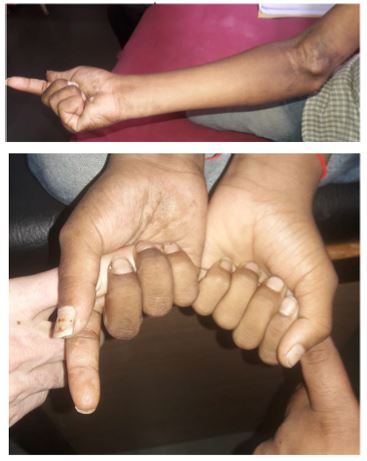Clinical Image - Volume 3 - Issue 5
Hand of benediction: An indicator of median neuropathy
Parikshit Ashok Muley1; Pranjali Parikshit Muley1*; Gulshan Bandre2; Abhishek Sambre3
1Professor in Physiology (Neurophysiology), Datta Meghe Medical College & Shalinitai Meghe Hospital and Research Center, Nagpur, India.
2Department of Microbiology, Jawaharlal Nehru Medical College, Datta Meghe Institute of Higher Education and Research (DU), Sawangi, Wardha, India.
3Neurophysiologist at Galaxy Vidarbha Diagnostics, Nagpur, India.
Received Date : Oct 02, 2023
Accepted Date : Oct 23, 2023
Published Date: Oct 30, 2023
Copyright:© Pranjali Muley 2023
*Corresponding Author : Pranjali Muley, Professor in Physiology (Neurophysiology), Datta Meghe Medical College & Shalinitai Meghe Hospital and Research Center, Nagpur, India.
Email: drpranjali11@gmail.com
DOI: Doi.org/10.55920/2771-019X/1575
Abstract
A common hand motion known as the Hand of Benediction is connected to blessings and spiritual significance. In addition to its symbolic significance, this hand position is regarded by medical professionals as a crucial indicator of median neuropathy. The image in the article explores the relationship between the Hand of Benediction and dysfunction of the median nerve, emphasising its clinical importance and implications for diagnosis.
Anatomy
It is important to study the anatomy of the median nerve in order to comprehend how the Hand of Benediction and median neuropathy are related. The median nerve is a major peripheral nerve in the upper limb, originating from the brachial plexus and extending down the arm. The median nerve, commonly known as the "eye of the hand," is a mixed nerve that plays a crucial part in the daily functioning of the hand [1]. It controls the abduction of the thumb, flexion of the hand at the wrist, and flexion of the digital phalanx of the fingers by innervating the group of flexor-pronator muscles in the forearm and the majority of the musculature found in the radial region of the hand. The median nerve allows the palmer face of the thumb, the index, middle, and radial sides of the ring finger, as well as the entire palmar region of the radial half of the hand, to receive sensory innervation. It gives the thumb, index finger, middle finger, and half of the ring finger sensation and motor control. The Hand of Benediction and Median Neuropathy: The term "median neuropathy" refers to the compression or injury of the median nerve, which causes functional limitations and distinctive clinical signs [2]. Pain, numbness, and weakness in the hand and fingers, especially the thumb, index, and middle fingers is present.
The Hand of Benediction is one unique indication of median neuropathy at the forearm or elbow [3]. The inability of the thumb, index, and middle fingers to bend at the metacarpophalangeal joints when trying to make a fist is what distinguishes this physical finding. The distal interphalangeal joint (DIP) and proximal interphalangeal joint (PIP) of the index finger do not flex, giving the appearance of a pointed finger These fingers, however, remain extended, imitating the hand motion used to express blessings. This problem happens as a result of an imbalance in finger flexion and extension caused by the paralysis or weakening of the muscles regulated by the median nerve. Diagnosis and Clinical Importance: When evaluating patients who appear with hand and wrist diseases, the Hand of Benediction sign must be present. Examining it might help doctors diagnose median neuropathy and distinguish it from other illnesses that might present with similar symptoms
Conclusion
The Hand of Benediction has important clinical significance as a diagnostic sign for median neuropathy. In order to effectively treat patients with median nerve dysfunction and enhance hand function, healthcare providers must be aware of the anatomical causes of this hand posture.

References
- Dydyk AM, Negrete G, Sarwan G, et al. Median Nerve Injury. In: StatPearls [Internet]. Treasure Island (FL): StatPearls Publishing; 2023. Available from: https://www.ncbi.nlm.nih.gov/books/ NBK553109/.
- Burton, C., Chesterton, L. S., & Davenport, G. Diagnosing and managing carpal tunnel syndrome in primary care. The British journal of general practice: the journal of the Royal College of General Practitioners. 2014; 64(622): 262-263. https://doi. org/10.3399/bjgp14X679903.
- The Hand Examination Stanford Medicine 25”. stanfordmedicine25.stanford.edu. Stanford Medicine. Retrieved. 2017.

